初中英语总复习-动词时态解题技巧课件(共65张PPT)
文档属性
| 名称 | 初中英语总复习-动词时态解题技巧课件(共65张PPT) |  | |
| 格式 | ppt | ||
| 文件大小 | 4.3MB | ||
| 资源类型 | 试卷 | ||
| 版本资源 | 通用版 | ||
| 科目 | 英语 | ||
| 更新时间 | 2022-03-31 20:52:23 | ||
图片预览

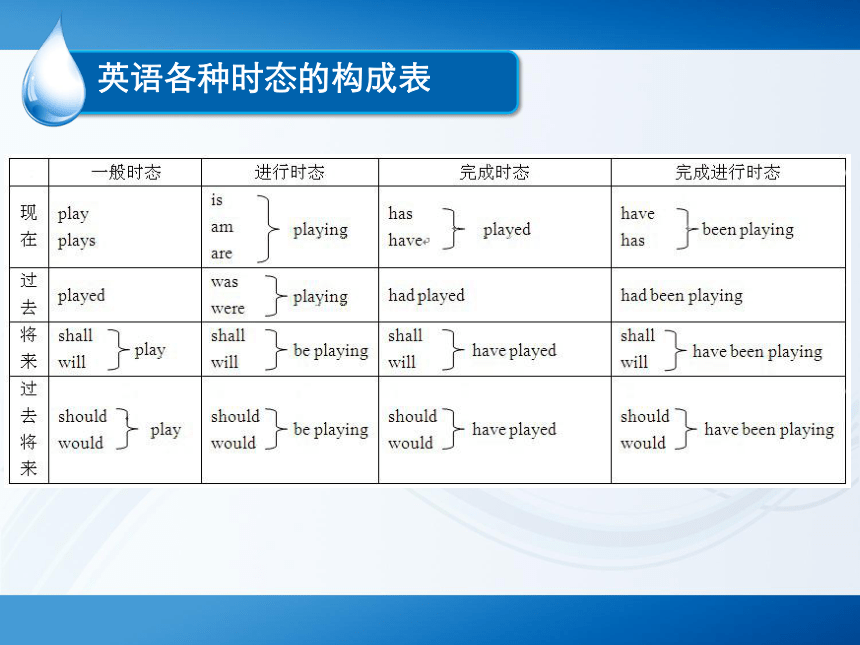

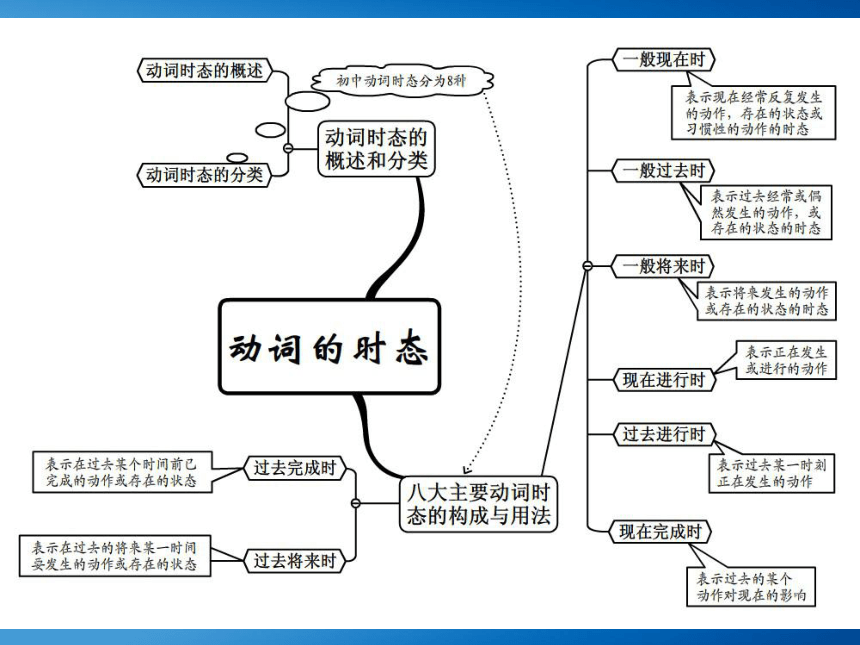

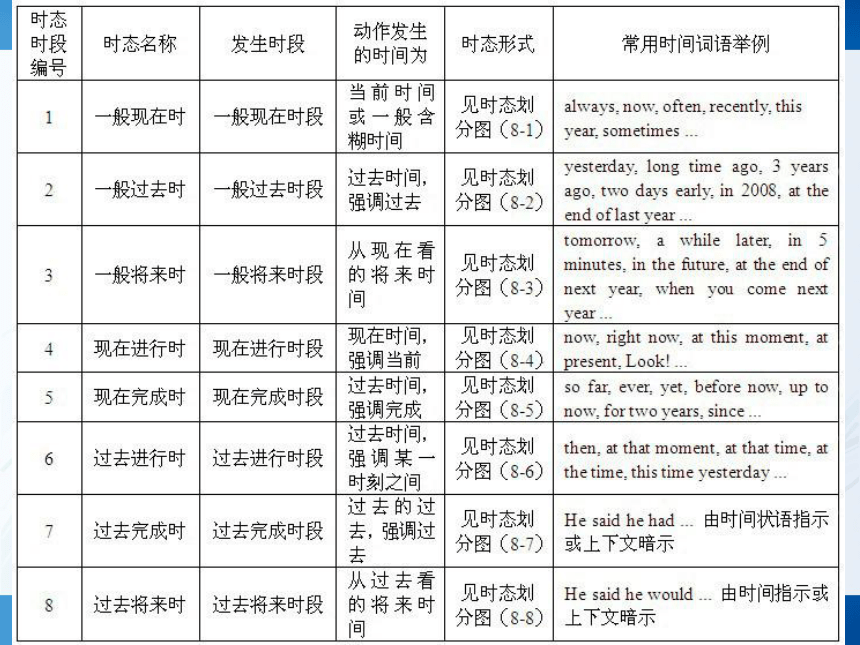



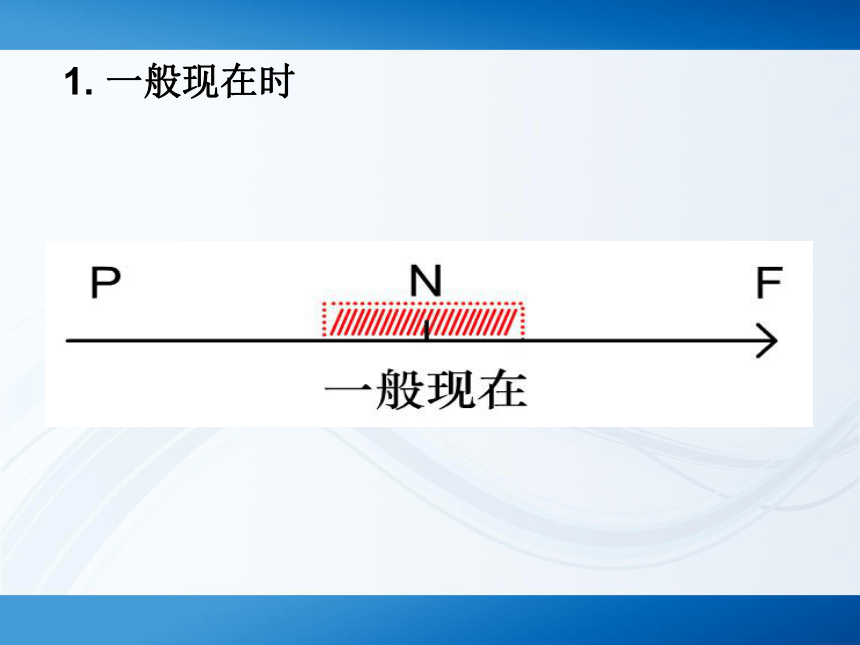

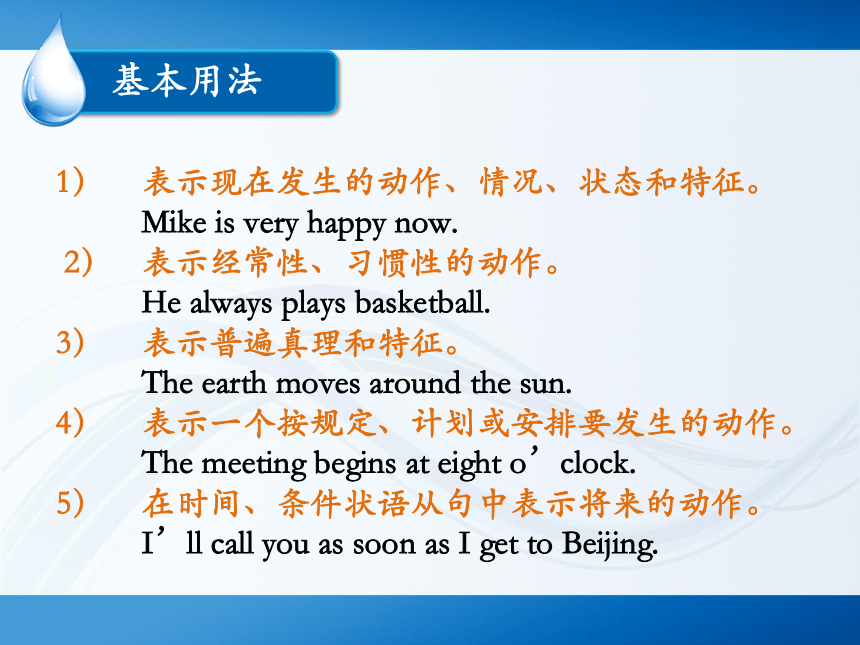
文档简介
(共65张PPT)
动词时态
制作:Henry
英语各种时态的构成表
一、谓语动词八种时态的思 维导图
二、谓语动词八种时态、时段一览表
三、谓语动词八种时态的划分图
四、谓语动词八种时态的划分图
1. 一般现在时
动词be
一般现在时
am I am ...
is he/she/it is ...
are we/you/they are ...
动词第三人称
单数变化
+s
write – writes
+es
go – goes
wash – washes
watch – watches
fix – fixes
变y为i+es
study – studies
辅音字母+y结尾的词
特殊变化
have – has
闪
记
基本用法
1) 表示现在发生的动作、情况、状态和特征。
Mike is very happy now.
2) 表示经常性、习惯性的动作。
He always plays basketball.
3) 表示普遍真理和特征。
The earth moves around the sun.
4) 表示一个按规定、计划或安排要发生的动作。
The meeting begins at eight o’clock.
5) 在时间、条件状语从句中表示将来的动作。
I’ll call you as soon as I get to Beijing.
例题1
Jason and Thomas __________ brothers. They study at the
same school.
A. be B. am C. is D. are
are
解题思路
Jason and Thomas
主语是第三人称复数
关键词study
对时态的判断
例题2
— Can your father drive
— Yes, and he usually __________ me to school.
A. drove B. is driving C. drives D. has driven
drives
解题思路
解题思路
关键词
can
usually关键词
判断为一般现在时
小结
概念:经常、反复发生的动作或行为及现在的某种状况。
时间状语:often, usually, always, sometimes, every week (day, year, month ...), once a week, on Sundays, etc.
基本结构:①be动词;②行为动词
否定形式:① am/is/are +not;②此时态的谓语动词若为行为动词,则在其前加don’t,如主语为第三人称单数,则用doesn’t,同时还原行为动词。
一般疑问句:①把be动词放于句首;②用助动词do提问,如主语为第三人称单数,则用does,同时,还原行为动词。
2. 一般过去时
重读闭音节,双写辅音字母加ed
行为动词的过去式
carry — carried
like — liked
stop — stopped
work — worked
以e结尾,直接加d
辅音字母加y,变y为i,加ed
直接在词尾加ed
动词be的过去式变化
am — was
is — was
are — were
闪记:
基本用法
1)在确定的过去时间里所发生的动作或存在的状态。
Where did you go yesterday
2)表示过去经常性或习惯性的动作。
Did he often go swimming last summer
3)表示主语过去的特征或性格。
Her English was very good at that time.
4)在时间和条件状语从句中,用一般过去时代替过
去将来时。
He said he would call me as soon as he
arrived in Shanghai.
例题1
— When __________ your mother __________ you that
blue dress, Mary
— Sorry, I really can’t remember.
A. does; buy B. has; bought C. had; bought D. did; buy
did buy
解题思路
看答句
不记得什么时候
Sorry, I really can’t remember.
判断为过去时态
连衣裙已经买过了
看问句
例题2
— Nancy is not coming to the party tonight.
— But she _________ me she’d love to.
A. tells B. told C. had told D. is telling
told
解题思路
看答句
she’d love to.
’d是would的缩写
判断为宾语从句
判断为一般过去时
因为从句是过去式,所以主句用相应的过去范畴时态
小结
概念:过去某个时间里发生的动作或状态;过去习惯性、经常性的动作、行为。
时间状语:ago, yesterday, the day before yesterday, last week (year, night, month ...), in 1989, just now, at the age of 5, one day, long long ago, once upon a time, etc.
基本结构:①be动词;②行为动词
否定形式:① was/were+not;②在行为动词前加didn’t,同时还原行为动词。
一般疑问句:①was或were放在句首;②用助动词do的过去式did提问,同时还原行为动词。
3. 一般将来时
闪记:
一般将来时的构成
否定句
肯定句
一般疑问句
特殊疑问句
Will/Shall +主语+动词原形
主语+will/shall +not+动词原形+ ...
主语+will/shall +动词原形+...
疑问词+一般疑问句?
基本用法
1) 表示在将来某个时间要发生的动作或存在
的状态,一般会与表示将来的时间状语连用。
We will go to see the film tomorrow.
2) 用在一些主从复合句中。
I’ll call you as soon as I get there.
例题1
There __________ a talk show on CCTV-1 at night this
evening.
A. will have B. is going to be
C. is having D. will be have
B
解题思路
this evening
判断为
将来时态
there is gong to be
关键词
例题2
— Please give this note to John.
— OK. I’ll give it to him as soon as he _________.
A. is coming back B. will come back
C. comes back D. come back
C
解题思路
as soon as
状语从句
主将,从现
comes back
关键词
小结
概念:表示将要发生的动作或存在的状态及打算、计划或准备做某事。
时间状语:tomorrow, next day (week, month, year ...), soon, in a few minutes, by ..., the day after tomorrow, etc.
基本结构:①am/is/are/going to +do;②will/shall+do
否定形式:①am/is/are +not+going to +do;② will/shall+not+do
一般疑问句:①be放于句首;② will/shall提到句首
4. 现在进行时
闪记:
现在进行时的构成
否定句
肯定句
一般疑问句
特殊疑问句
Be (Is/Are)+主语+现在分词
主语+be (am, is, are)+not+现在分词+...
主语+be(am, is, are)+现在分词+...
疑问词+一般疑问句?
基本用法
1) 表示说话时正在进行的动作。
Listen! She is singing a song.
2) 表示现阶段的正在进行的动作。
What are you doing these days
例题1
Don’t turn on the TV. Grandma __________ now.
A. is sleeping B. will sleep
C. slept D. sleeps
A
解题思路
now
判断为现在进行时
关键词
例题2
— Where is Mike He asked me to go out for a walk this
evening.
— Maybe he __________ TV in the living room now.
A. watched B. will watch C. is watching D. watches
C
解题思路
关键词、句
now
Where is Mike
判断为现在进行时
小结
概念:表示现阶段或说话时正在进行的动作及行为。
时间状语:now, at this time, these days, etc.
基本结构:am/is/are +doing
否定形式:am/is/are +not+doing
一般疑问句:把be动词放在句首
5. 现在完成时
闪记:
现在完成时的构成
否定句
肯定句
一般疑问句
特殊疑问句
Have/Has+主语+过去分词
主语+have/has +not+过去分词+...
主语+have/has+过去分词+...
疑问词+一般疑问句?
基本用法
1) 表示过去发生的动作对现在产生的影响或
结果,或说话时已完成的动作。
I have finished my homework.
2) 表示从过去开始,持续到现在的动作或状态,
往往和“for ...”,“since ...”表述的一段
时间状语连用。
He has learnt English for six years.
She has studied playing piano since 2006.
例题1
— Hello! Can I speak to Alice
— Sorry. She isn’t here right now. She __________ to
the shop.
A. goes B. will go C. has gone D. was going
C
解题思路
关键词
She isn’t here right now.
当事人不在,用have/has gone
例题2
Mr. Brown and his family have __________ New York
for a few weeks.
A. been in B. worked C. gone to D. left for
A
解题思路
关键词
been in与表示一段时间的状语连用
for a few weeks
例题3
— He _______ the English-Chinese dictionary for about
twenty years, but it is still new.
— What a careful man!
A. has bought B. has borrowed
C. has had D. borrowed
C
解题思路
关键词
buy,borrow为短暂性动词,不能与表示一段时间的时间状语连用,排除答案A、B、D
for about twenty years
小结
概念:过去发生或已经完成的动作对现在造成的影响或结果,或从过去已经开始,持续到现在的动作或状态。
时间状语:recently, lately, since..., for..., in the past few years, etc.
基本结构:have/has +done
否定形式:have/has +not+done
一般疑问句:have/has放于句首
6. 过去进行时
闪记:
过去进行时的构成
否定句
肯定句
一般疑问句
特殊疑问句
Be+主语+现在分词
主语+ be (was/ were) +not+现在分词+...
主语+ be +现在分词+...
疑问词+一般疑问句?
基本用法
1) 表示过去某个时刻或某一阶段正在进行的动作。
He was preparing his lecture all day yesterday.
2) 与表示过去的时间状语从句连用。
They were still working when I left.
例题1
— Did you see a girl in while pass by just now
— No, sir. I __________ a newspaper.
A. Read B. was reading C. would read D. am reading
B
解题思路
关键词just now
判定为过去范畴的时态,排除A、D
根据题意应是刚才正在做什么
例题2
— Were you at home at 9 o’clock last night
— Yes, I __________ a shower at that time.
A. Took B. was taking C. was taken D. am taking
B
解题思路
关键词
at 9 o’clock last night
at that time
可以判定用过去进行时
小结
概念:表示过去某段时间或某一时刻正在发生或进行的行为或动作。
时间状语:at this time yesterday,at that time或以when引导的谓语动词是一般过去时的时间状语等。
基本结构:was/were +doing
否定形式:was/were +not+doing
一般疑问句:把was或were放在句首
7. 过去完成时
闪记:
过去完成时的构成
否定句
肯定句
一般疑问句
特殊疑问句
Had+主语+过去分词
主语 + had + not +过去分词+...
主语+ had +过去分词+...
疑问词+一般疑问句?
基本用法
1) 表示过去某一时刻之前的动作或状态。
By the end of last term, I had learnt more
than 2,000 English words.
2) 表示过去某一时段时间内或从过去某一特定
时刻开始并一直延续到过去的另一时刻的动作。
I had been a teacher for 10 years before I
came here.
例题1
By the end of last year, we __________ more than
2,000 words.
A. learnt B. have learnt
C. had learnt D. learn
C
解题思路
关键词
判断用过去完成时态
By the end of last year
小结
概念:以过去某一时间为标准,在此以前发生的动作或行为,或在过去某动作之前完成的行为,即“过去的过去”。
时间状语:before, by the end of last year (term, month ...), etc.
基本结构:had +done
否定形式:had +not+done
一般疑问句:had放于句首
8. 过去将来时
闪记:
过去将来时的构成
否定句
肯定句
一般疑问句
特殊疑问句
Would/Should+主语+动原...
主语+would/ should + not +动词原形+...
主语+would/ should+动原+...
疑问词+一般疑问句?
基本用法
1) 表示过去习惯性的动作或者存在的状态。
Every day, Mrs. Wang would go and talk
with her students.
2) 用于间接引语及宾语从句中。
I didn’t know if she would come.
例题1
I wondered ____________________.
when will the meeting end
B. when the meeting will end
C. when would the meeting end
D. when the meeting would end
D
解题思路
I wondered
关键词
宾语从句
排除答案A、C
从句用陈述句语序
判定从句用过去范畴的时态
I wondered
小结
概念:立足于过去某一时刻,从过去看将来,常用于宾语从句中。
时间状语:the next day (morning, year ...), the following month (week ...), etc.
基本结构:①was/were/going to +do;② would/should +do
否定形式:①was/were/not+going to +do;②would/should +not+do
一般疑问句:①was或were放于句首;②would/should提到句首
五、谓语动词八种时态、语态和几种变化形式
do/does
am/is/are done
did/-ed
was/were done
will do
will be done
am/is/are doing
am/is/are being done
have/has done
have/has been done
was/were doing
was/were being done
had done
had been done
would do
would be done
do; not do; to do; not to do
do; don’t do
doing
doing
done
六、下面我们试着做做以下的试题
Look. Mary _____ a nice dog.
She _____ it just now.
has drawn, drew B. drew, has drawn
C. is drawing, drew D. is drawing, has drawn
【解析】在“Look”、“It’s evening”、“Where is sb. … ”
等句子后面,可能要用““现在进行时”,也有可能要用
“现在完成时”。要根据具体情况来具体分析,考虑问题
一定要从整体情况着眼。本题后半句“just now”意为
“刚才”,很明显要用“一般过去时”,因此前句如用
“现在进行时”就不妥,造成句意逻辑上的错误。前句用
“现在完成时”才对。所以本题答案应为“A”。
2. This kind of fridge _____ very well.
A. sell B. sells
C. are sold D. is sold
【解析】在英语中,表达某物销路不错,要用表示“特点”
的“一般现在时”的主动形式,而不能用“被卖”这种被动
语态形式来表示。由于本句主语“this kind of fridge”是单数
第三人称,所以本题答案应该选“B”。
3. What _____ Mr. Smith He looks worried
so much.
A. happens with B. happens to
C. happened with D. happened to
【解析】在英语中,“发生”通常可译为“happened”或
“took place”,要注意它不能变“被动语态”。本题之意
是“史密斯先生出了什么事?他显得很焦虑。”因此,由题
意看,这里表示事情已经发生过了,应该用“一般过去时”
的“happened to sb”固定词组来表达,所以
本题答案应该选“D”。
4. The book _____ by me. I _____ it to a friend
of mine already .
A. is written, sent B. is written, have sent
C. was written, sent D. was written, have sent
【解析】“书是被某人写的”、“书是在某地方被写的”都是
表示发生在以前的动作,该用一般过去时被动语态。如果说
“书是用英语写的”,那就是指书的特点了,就该用一般现
在时被动语态了,排除A、B。由第二句话中的“already”
可知,用完成时符合题意,所以本题答案应该选“D”。
5. Mr. Jackson _____ the city quite well since
he _____ in the city for a couple of years.
A. knows, was B. has known, was
C. knows, has been D. has known, has been
【解析】本句中的“since”不是“自从”之意,因此,前半
句与后半句用“现在完成时”和“一般现在时”的形式是错
误的。本句中的“since”意为“由于”,与“as”近义。
根据句意,“熟悉城市”是表示杰克逊先生的“特点”,
要用“一般现在时”表达;“他来到这个城市有两、三年了”
是表示到现在为止的结果情况,要用“现在完成时”表达。
所以本题答案应该选“C”。
Thank you
动词时态
制作:Henry
英语各种时态的构成表
一、谓语动词八种时态的思 维导图
二、谓语动词八种时态、时段一览表
三、谓语动词八种时态的划分图
四、谓语动词八种时态的划分图
1. 一般现在时
动词be
一般现在时
am I am ...
is he/she/it is ...
are we/you/they are ...
动词第三人称
单数变化
+s
write – writes
+es
go – goes
wash – washes
watch – watches
fix – fixes
变y为i+es
study – studies
辅音字母+y结尾的词
特殊变化
have – has
闪
记
基本用法
1) 表示现在发生的动作、情况、状态和特征。
Mike is very happy now.
2) 表示经常性、习惯性的动作。
He always plays basketball.
3) 表示普遍真理和特征。
The earth moves around the sun.
4) 表示一个按规定、计划或安排要发生的动作。
The meeting begins at eight o’clock.
5) 在时间、条件状语从句中表示将来的动作。
I’ll call you as soon as I get to Beijing.
例题1
Jason and Thomas __________ brothers. They study at the
same school.
A. be B. am C. is D. are
are
解题思路
Jason and Thomas
主语是第三人称复数
关键词study
对时态的判断
例题2
— Can your father drive
— Yes, and he usually __________ me to school.
A. drove B. is driving C. drives D. has driven
drives
解题思路
解题思路
关键词
can
usually关键词
判断为一般现在时
小结
概念:经常、反复发生的动作或行为及现在的某种状况。
时间状语:often, usually, always, sometimes, every week (day, year, month ...), once a week, on Sundays, etc.
基本结构:①be动词;②行为动词
否定形式:① am/is/are +not;②此时态的谓语动词若为行为动词,则在其前加don’t,如主语为第三人称单数,则用doesn’t,同时还原行为动词。
一般疑问句:①把be动词放于句首;②用助动词do提问,如主语为第三人称单数,则用does,同时,还原行为动词。
2. 一般过去时
重读闭音节,双写辅音字母加ed
行为动词的过去式
carry — carried
like — liked
stop — stopped
work — worked
以e结尾,直接加d
辅音字母加y,变y为i,加ed
直接在词尾加ed
动词be的过去式变化
am — was
is — was
are — were
闪记:
基本用法
1)在确定的过去时间里所发生的动作或存在的状态。
Where did you go yesterday
2)表示过去经常性或习惯性的动作。
Did he often go swimming last summer
3)表示主语过去的特征或性格。
Her English was very good at that time.
4)在时间和条件状语从句中,用一般过去时代替过
去将来时。
He said he would call me as soon as he
arrived in Shanghai.
例题1
— When __________ your mother __________ you that
blue dress, Mary
— Sorry, I really can’t remember.
A. does; buy B. has; bought C. had; bought D. did; buy
did buy
解题思路
看答句
不记得什么时候
Sorry, I really can’t remember.
判断为过去时态
连衣裙已经买过了
看问句
例题2
— Nancy is not coming to the party tonight.
— But she _________ me she’d love to.
A. tells B. told C. had told D. is telling
told
解题思路
看答句
she’d love to.
’d是would的缩写
判断为宾语从句
判断为一般过去时
因为从句是过去式,所以主句用相应的过去范畴时态
小结
概念:过去某个时间里发生的动作或状态;过去习惯性、经常性的动作、行为。
时间状语:ago, yesterday, the day before yesterday, last week (year, night, month ...), in 1989, just now, at the age of 5, one day, long long ago, once upon a time, etc.
基本结构:①be动词;②行为动词
否定形式:① was/were+not;②在行为动词前加didn’t,同时还原行为动词。
一般疑问句:①was或were放在句首;②用助动词do的过去式did提问,同时还原行为动词。
3. 一般将来时
闪记:
一般将来时的构成
否定句
肯定句
一般疑问句
特殊疑问句
Will/Shall +主语+动词原形
主语+will/shall +not+动词原形+ ...
主语+will/shall +动词原形+...
疑问词+一般疑问句?
基本用法
1) 表示在将来某个时间要发生的动作或存在
的状态,一般会与表示将来的时间状语连用。
We will go to see the film tomorrow.
2) 用在一些主从复合句中。
I’ll call you as soon as I get there.
例题1
There __________ a talk show on CCTV-1 at night this
evening.
A. will have B. is going to be
C. is having D. will be have
B
解题思路
this evening
判断为
将来时态
there is gong to be
关键词
例题2
— Please give this note to John.
— OK. I’ll give it to him as soon as he _________.
A. is coming back B. will come back
C. comes back D. come back
C
解题思路
as soon as
状语从句
主将,从现
comes back
关键词
小结
概念:表示将要发生的动作或存在的状态及打算、计划或准备做某事。
时间状语:tomorrow, next day (week, month, year ...), soon, in a few minutes, by ..., the day after tomorrow, etc.
基本结构:①am/is/are/going to +do;②will/shall+do
否定形式:①am/is/are +not+going to +do;② will/shall+not+do
一般疑问句:①be放于句首;② will/shall提到句首
4. 现在进行时
闪记:
现在进行时的构成
否定句
肯定句
一般疑问句
特殊疑问句
Be (Is/Are)+主语+现在分词
主语+be (am, is, are)+not+现在分词+...
主语+be(am, is, are)+现在分词+...
疑问词+一般疑问句?
基本用法
1) 表示说话时正在进行的动作。
Listen! She is singing a song.
2) 表示现阶段的正在进行的动作。
What are you doing these days
例题1
Don’t turn on the TV. Grandma __________ now.
A. is sleeping B. will sleep
C. slept D. sleeps
A
解题思路
now
判断为现在进行时
关键词
例题2
— Where is Mike He asked me to go out for a walk this
evening.
— Maybe he __________ TV in the living room now.
A. watched B. will watch C. is watching D. watches
C
解题思路
关键词、句
now
Where is Mike
判断为现在进行时
小结
概念:表示现阶段或说话时正在进行的动作及行为。
时间状语:now, at this time, these days, etc.
基本结构:am/is/are +doing
否定形式:am/is/are +not+doing
一般疑问句:把be动词放在句首
5. 现在完成时
闪记:
现在完成时的构成
否定句
肯定句
一般疑问句
特殊疑问句
Have/Has+主语+过去分词
主语+have/has +not+过去分词+...
主语+have/has+过去分词+...
疑问词+一般疑问句?
基本用法
1) 表示过去发生的动作对现在产生的影响或
结果,或说话时已完成的动作。
I have finished my homework.
2) 表示从过去开始,持续到现在的动作或状态,
往往和“for ...”,“since ...”表述的一段
时间状语连用。
He has learnt English for six years.
She has studied playing piano since 2006.
例题1
— Hello! Can I speak to Alice
— Sorry. She isn’t here right now. She __________ to
the shop.
A. goes B. will go C. has gone D. was going
C
解题思路
关键词
She isn’t here right now.
当事人不在,用have/has gone
例题2
Mr. Brown and his family have __________ New York
for a few weeks.
A. been in B. worked C. gone to D. left for
A
解题思路
关键词
been in与表示一段时间的状语连用
for a few weeks
例题3
— He _______ the English-Chinese dictionary for about
twenty years, but it is still new.
— What a careful man!
A. has bought B. has borrowed
C. has had D. borrowed
C
解题思路
关键词
buy,borrow为短暂性动词,不能与表示一段时间的时间状语连用,排除答案A、B、D
for about twenty years
小结
概念:过去发生或已经完成的动作对现在造成的影响或结果,或从过去已经开始,持续到现在的动作或状态。
时间状语:recently, lately, since..., for..., in the past few years, etc.
基本结构:have/has +done
否定形式:have/has +not+done
一般疑问句:have/has放于句首
6. 过去进行时
闪记:
过去进行时的构成
否定句
肯定句
一般疑问句
特殊疑问句
Be+主语+现在分词
主语+ be (was/ were) +not+现在分词+...
主语+ be +现在分词+...
疑问词+一般疑问句?
基本用法
1) 表示过去某个时刻或某一阶段正在进行的动作。
He was preparing his lecture all day yesterday.
2) 与表示过去的时间状语从句连用。
They were still working when I left.
例题1
— Did you see a girl in while pass by just now
— No, sir. I __________ a newspaper.
A. Read B. was reading C. would read D. am reading
B
解题思路
关键词just now
判定为过去范畴的时态,排除A、D
根据题意应是刚才正在做什么
例题2
— Were you at home at 9 o’clock last night
— Yes, I __________ a shower at that time.
A. Took B. was taking C. was taken D. am taking
B
解题思路
关键词
at 9 o’clock last night
at that time
可以判定用过去进行时
小结
概念:表示过去某段时间或某一时刻正在发生或进行的行为或动作。
时间状语:at this time yesterday,at that time或以when引导的谓语动词是一般过去时的时间状语等。
基本结构:was/were +doing
否定形式:was/were +not+doing
一般疑问句:把was或were放在句首
7. 过去完成时
闪记:
过去完成时的构成
否定句
肯定句
一般疑问句
特殊疑问句
Had+主语+过去分词
主语 + had + not +过去分词+...
主语+ had +过去分词+...
疑问词+一般疑问句?
基本用法
1) 表示过去某一时刻之前的动作或状态。
By the end of last term, I had learnt more
than 2,000 English words.
2) 表示过去某一时段时间内或从过去某一特定
时刻开始并一直延续到过去的另一时刻的动作。
I had been a teacher for 10 years before I
came here.
例题1
By the end of last year, we __________ more than
2,000 words.
A. learnt B. have learnt
C. had learnt D. learn
C
解题思路
关键词
判断用过去完成时态
By the end of last year
小结
概念:以过去某一时间为标准,在此以前发生的动作或行为,或在过去某动作之前完成的行为,即“过去的过去”。
时间状语:before, by the end of last year (term, month ...), etc.
基本结构:had +done
否定形式:had +not+done
一般疑问句:had放于句首
8. 过去将来时
闪记:
过去将来时的构成
否定句
肯定句
一般疑问句
特殊疑问句
Would/Should+主语+动原...
主语+would/ should + not +动词原形+...
主语+would/ should+动原+...
疑问词+一般疑问句?
基本用法
1) 表示过去习惯性的动作或者存在的状态。
Every day, Mrs. Wang would go and talk
with her students.
2) 用于间接引语及宾语从句中。
I didn’t know if she would come.
例题1
I wondered ____________________.
when will the meeting end
B. when the meeting will end
C. when would the meeting end
D. when the meeting would end
D
解题思路
I wondered
关键词
宾语从句
排除答案A、C
从句用陈述句语序
判定从句用过去范畴的时态
I wondered
小结
概念:立足于过去某一时刻,从过去看将来,常用于宾语从句中。
时间状语:the next day (morning, year ...), the following month (week ...), etc.
基本结构:①was/were/going to +do;② would/should +do
否定形式:①was/were/not+going to +do;②would/should +not+do
一般疑问句:①was或were放于句首;②would/should提到句首
五、谓语动词八种时态、语态和几种变化形式
do/does
am/is/are done
did/-ed
was/were done
will do
will be done
am/is/are doing
am/is/are being done
have/has done
have/has been done
was/were doing
was/were being done
had done
had been done
would do
would be done
do; not do; to do; not to do
do; don’t do
doing
doing
done
六、下面我们试着做做以下的试题
Look. Mary _____ a nice dog.
She _____ it just now.
has drawn, drew B. drew, has drawn
C. is drawing, drew D. is drawing, has drawn
【解析】在“Look”、“It’s evening”、“Where is sb. … ”
等句子后面,可能要用““现在进行时”,也有可能要用
“现在完成时”。要根据具体情况来具体分析,考虑问题
一定要从整体情况着眼。本题后半句“just now”意为
“刚才”,很明显要用“一般过去时”,因此前句如用
“现在进行时”就不妥,造成句意逻辑上的错误。前句用
“现在完成时”才对。所以本题答案应为“A”。
2. This kind of fridge _____ very well.
A. sell B. sells
C. are sold D. is sold
【解析】在英语中,表达某物销路不错,要用表示“特点”
的“一般现在时”的主动形式,而不能用“被卖”这种被动
语态形式来表示。由于本句主语“this kind of fridge”是单数
第三人称,所以本题答案应该选“B”。
3. What _____ Mr. Smith He looks worried
so much.
A. happens with B. happens to
C. happened with D. happened to
【解析】在英语中,“发生”通常可译为“happened”或
“took place”,要注意它不能变“被动语态”。本题之意
是“史密斯先生出了什么事?他显得很焦虑。”因此,由题
意看,这里表示事情已经发生过了,应该用“一般过去时”
的“happened to sb”固定词组来表达,所以
本题答案应该选“D”。
4. The book _____ by me. I _____ it to a friend
of mine already .
A. is written, sent B. is written, have sent
C. was written, sent D. was written, have sent
【解析】“书是被某人写的”、“书是在某地方被写的”都是
表示发生在以前的动作,该用一般过去时被动语态。如果说
“书是用英语写的”,那就是指书的特点了,就该用一般现
在时被动语态了,排除A、B。由第二句话中的“already”
可知,用完成时符合题意,所以本题答案应该选“D”。
5. Mr. Jackson _____ the city quite well since
he _____ in the city for a couple of years.
A. knows, was B. has known, was
C. knows, has been D. has known, has been
【解析】本句中的“since”不是“自从”之意,因此,前半
句与后半句用“现在完成时”和“一般现在时”的形式是错
误的。本句中的“since”意为“由于”,与“as”近义。
根据句意,“熟悉城市”是表示杰克逊先生的“特点”,
要用“一般现在时”表达;“他来到这个城市有两、三年了”
是表示到现在为止的结果情况,要用“现在完成时”表达。
所以本题答案应该选“C”。
Thank you
同课章节目录
- 词法
- 名词
- 动词和动词短语
- 动词语态
- 动词时态
- 助动词和情态动词
- 非谓语动词
- 冠词
- 代词
- 数词和量词
- 形容词副词及其比较等级
- 介词和介词短语
- 连词和感叹词
- 构词法
- 相似、相近词比较
- 句法
- 陈述句
- 一般疑问句和否定疑问句
- 特殊疑问句及选择疑问句
- 反意疑问句
- 存在句(There be句型)
- 宾语从句
- 定语从句
- 状语从句
- 主谓一致问题
- 简单句
- 并列句
- 复合句
- 主谓一致
- 主、表语从句
- 名词性从句
- 直接引语和间接引语
- 虚拟语气
- 感叹句
- 强调句
- 倒装句
- 祈使句
- 句子的成分
- 句子的分类
- 题型专区
- 单项选择部分
- 易错题
- 完形填空
- 阅读理解
- 词汇练习
- 听说训练
- 句型转换
- 补全对话
- 短文改错
- 翻译
- 书面表达
- 任务型阅读
- 语法填空
- 其他资料
